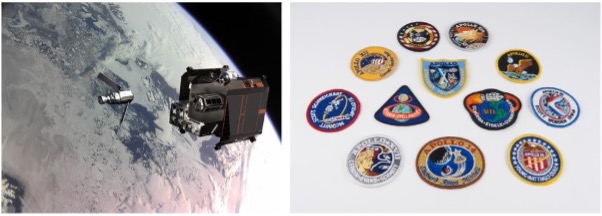

Today the Science Museum and Magdrive, a UK space company, announced Troy Elsworth, aged 12, has won a national competition for children to design the mission patch for Magdrive’s first in-orbit launch of its plasma thrusters. Troy was presented with an embroidered patch of his winning design on stage at the UK Space Conference by Libby Jackson, Head of Space at the Science Museum, and Chuong Van Dang, Chief of Staff, Magdrive. Troy’s design was worn by the Magdrive team for the recent launch of their Going Rogue mission.
More than 1600 entries were received for the competition from children across the UK, with the designs judged on their connection to the mission, illustration of space exploration and creativity. Seven designs were shortlisted by the judging panel, with Troy’s winning design selected due to an imaginative design that captured the thruster technology in action.
When I heard the mission patch competition advertised on the radio I decided to enter as I had recently been to the Kennedy Space Center and liked seeing the mission patches. The competition gave me the chance to see if I could design one myself. I got my inspiration from the Magdrive maximum thrust image and wanted to show the satellite reaching for the stars.”
Mission Patch Winner, Troy Elsworth
Troy’s winning patch will be displayed alongside Magdrive’s prototype thrusters in the new Space gallery at the Science Museum from 20 September 2025. The patch is now part of the Science Museum Group Collection, joining other space technology items, including the Soyuz spacecraft which carried astronaut Tim Peake into space and back, several rocket engines, historic spacesuits and mission patches from significant NASA missions. Troy and his family will also receive a behind-the-scenes tour of Magdrive’s laboratory located at the Harwell Campus, Oxford.
The mission patch competition was judged by a panel including Thomas Clayson (CTO and Co-Founder at Magdrive), Chuong Van Dang (Chief of Staff), Katrina Nichols (Head of Marketing), and Zola Dang. They were joined by three representatives from the Science Museum: Jon Long (Senior Explainer), Abbie MacKinnon (Curator of Space Technology), and Libby Jackson (Head of Space)
Our collaboration with the Science Museum is a powerful reminder of what’s possible when industry and education come together. Initiatives like this aren’t just about space, they’re about sparking imagination, building confidence, and helping young people see that they have a place in shaping the future. We were blown away by the creativity and vision shown by every child who entered the Going Rogue mission patch competition. Troy’s winning design captured something truly special, and we’re incredibly proud to carry a piece of that imagination into orbit. Congratulations, Troy, and thank you to every young person who took part. You are the future of space.”
Dr Thomas Clayson, CTO and Co-Founder at Magdrive
“I want to thank each of the more than 1600 children who entered our competition and shared their brilliant ideas with us. It was a joy – and a challenge – to pick just one winning design to represent Magdrive’s mission, the technology and the people who made both a reality. Troy’s design stood out because it captured the essence of the technology in a unique and visually appealing way. A good mission patch is interesting, original and tells a story, and Troy’s design ticked all those boxes. I am thrilled we can display Troy’s patch alongside Magdrive’s prototype thrusters in our new Space gallery at the Science Museum.”
Libby Jackson, Head of Space at the Science Museum


Magdrive’s thruster is a next-generation plasma propulsion system that uses a metal propellant and high-energy plasma to manoeuvre satellites in orbit. The recently launched Going Rogue mission is demonstrating the thruster’s performance by manoeuvring an ION satellite over a six-month period. With thousands of satellites now circling Earth, improved manoeuvrability is essential to prevent collisions and safeguard the satellite-powered services we rely on every day.
As most early astronauts were previously military pilots, the military tradition of wearing specially designed patches also became a custom of space missions, which has continued to this day. The winning mission patch will join historic Apollo mission patches and go on display in the Science Museum’s new Space gallery when it opens from 20 September 2025.